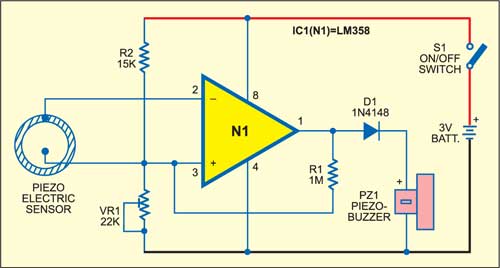 This miniature alarm unit protects your valuables from theft by sounding an alarm when somebody attempts to pick up your briefcase. It is a battery-operated gadget that can be hidden in a corner inside the briefcase. The circuit uses few components and is simple to fabricate.
This miniature alarm unit protects your valuables from theft by sounding an alarm when somebody attempts to pick up your briefcase. It is a battery-operated gadget that can be hidden in a corner inside the briefcase. The circuit uses few components and is simple to fabricate.
The main component of the circuit is a piezo-element used in buzzers. The piezo-element generates electric signals in response to pressure or vibration. It has capacitance of a few tens of nanofarads (nF). Like a capacitor, the piezo-element readily charges when a potential is applied and holds the charge until it is mechanically disturbed. Any mechanical vibration will rearrange the charge on the piezo-electric material with the release of energy.
The voltage developed across the piezo-sensor triggers IC LM358, which is used as a low-power transducer amplifier. IC LM358 works off 9 volts and has two independent high-gain op-amps with large DC gain of 100 dB.

Here the IC is configured as an inverting Schmitt trigger to convert input signals into a shaped output waveform. Preset VR1 sets a threshold voltage at the non-inverting input threshold of IC1. One end of feedback resistor R1 is connected to the output of the IC and the other end to the non-inverting input (pin 3) while the piezo-sensor is connected between the inverting and non-inverting pins.
When the signal from the piezo-sensor is low (standby mode), the output of IC1 is also low. Feedback resistor R1 pulls the non-inverting input voltage above the upper threshold voltage (UTV) of around 1.8 volts.
When the piezo-sensor is touched momentarily, it discharges the stored charge and the inverting input voltage exceeds the positive input and the output goes low. When this happens, the voltage at the positive input falls through VR1 to reach the lower threshold voltage (LTV). At this moment, the voltage at the inverting input is low due to the absence of the input signal. This causes the output to go high and the buzzer beeps.
The output of the IC falls when the input exceeds the UTV and rises when the input drops below the LTV. The difference between the UTV and the LTV is the hysteresis of the Schimdt trigger.
When the piezo-sensor is touched, the buzzer beeps for a few seconds even if the hand is withdrawn. This is because once the output swings high, any slight decrease in voltage at the negative input has no effect. Once begun, the change in state cannot be easily reversed.
Assemble the circuit on a general-purpose PCB as compact as possible and house in a small case. The piezo-sensor should be the smallest one with 10-15mm diameter. Connect it to the unit using a thin, shielded wire and glue on the lower side of the handle of the briefcase. A 3V battery is sufficient to power the circuit.






